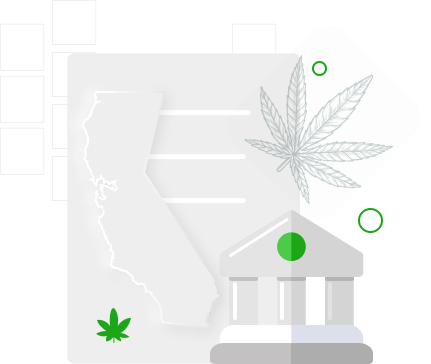How we can help
Business
Strategy
Alignment of goals, and resources to develop a strategy and execution plan for getting a dispensary license and launching a successful business.
Property Acquisition
Identify and acquire suitable and permittable properties for your cannabis business.
Compliance & Renewals
Maintain compliance with state and local agencies and navigate annual renewals.
How To Get a Dispensary License In 6 Steps
Dispensary operations face some fiercest
challenges getting operational and profitable.
How to get a dispensary license is a common question for entrepreneurs entering the cannabis industry, but getting a license is just one cog in the wheel of launching a successful business. Our process for helping clients get licenses also covers the other cogs that are required for success.
A dispensary business can be lucrative and is a great investment in a booming market like California, but there are some significant challenges getting there. First off, it’s highly competitive in the licensing phase. Many entities are competing for limited licenses at once.
Additionally, there are zoning restrictions, short application windows and tight caps on issuances. It’s critical to be well connected, well prepared, and ready to spring into action at a moment’s notice to get your dispensary license secured in your city of your choice.
Our team at BeGreenLegal has developed a proven process for acquiring property, obtaining licenses, and creating a strategy that will turn your dreams of building a profitable cannabis business into a reality.
Continue reading to discover more about our proven framework for guiding clients on how to get a dispensary license.
Strategize and develop a clear vision plan
Step one for how to get a dispensary license is to develop a winning strategy.
Your license approval hinges on your ability to prove that you have the knowledge and resources to build a successful cannabis business. In order to do that, you’ll need a rock solid business strategy and a clear vision plan.
When we first meet new clients, we ask the hard questions and get to know their true motivations, goals and skill sets. Do you have what it takes to be profitable and stay in compliance with strict regulations?
If you had dreams of opening up a small mom-and-pops shop as a retirement hobby, think again… you’re going to be up against some serious entrepreneurs and it’s survival of the fittest.
With dispensaries, strategy is more than just friendly customer service, great product selection, and reasonable prices. It’s first and foremost about branding and how the market is going to perceive you. You have to understand your ideal customer intimately and develop a brand that speaks directly to them and draws them in.
Your business plan should be prepared long before you apply for your license. Once that application window opens, you have to be ready to go. With BeGreenLegal as your partner, the second that application window opens you’ll be ready to spring into action.
Our team and BeGreenLegal will help our develop a game plan that includes:
- Forming an entity
- Developing a business framework
- Determining a scheduling plan
- Demonstrating financial stability
- Standardizing procedures
- Preparing a work plan

Acquiring the right property for your facility
Step two for how to get a dispensary license is to find a suitable property for your cannabis business’s specific requirements.
Acquiring property and obtaining your Conditional Use Permit is one of the biggest milestones you’ll experience as a cannabis entrepreneur.
Out of all the different cannabis businesses, including manufacturing, distribution, cultivation and testing, finding the right property for your dispensary is by far the hardest. Due to all the restrictions, you might only have four places a month in the whole state where you can apply!
It isn’t as simple as finding a “green-zoned” property and snatching it up. Just because an area allows cannabis manufacturing or distribution, doesn’t mean it will allow retail.
Finding the city is hard because most cities don’t even allow it. If they do, you’re limited to only certain neighborhoods. You can’t be too close to schools, parks, churches, daycares and other areas where kids may be present. On top of that, very few buildings will have the features you need.
Property Acquisition Process
Getting into the right property is a crucial step for any cannabis operation
Find Suitable Cities & Counties
Determine Permittable Zones
Find a Property
Renovate & Permit
Your average real estate agent is often unaware of all these nitty gritty details. It’s hard enough to find the specs you’re looking for but it’s even harder to keep up with the constantly changing cannabis legislation. Leveraging the experts at BeGreenLegal will guarantee you have access to the best viable properties with the least amount of headaches.
Once we create a shortlist of properties, we’ll personally visit them and analyze every aspect, including:
- Topography
- Access roads
- Bodies of water
- Property corners
- Walkways
- Trees
Most importantly, your dispensary needs to be in a convenient spot for customers to swing by on their way home from work. Location is king when it comes to retail!
Once you acquire your dream property and obtain your Conditional Use Permit, you’ll be ready to prepare an application package for approval.
Property Acquisition Process
Getting into the right property is a crucial step for any cannabis operation
- Find Suitable Cities & Counties
- Determine Permittable Zones
- Find a Property
- Renovate & Permit

Prepare an application package and submit it for approval
Step three for how to get a dispensary license is to prepare an application package that checks all the boxes that state and local authorities are looking for.
Even the most experienced, battle-tested entrepreneurs have a hard time preparing their application package for cannabis licensing. These documents are long and complicated and the regulations and protocol seem to change every other week.
Our team at BeGreenLegal will help you put together all the key pieces, like:
Operations
Odor control
Safety and security
Community relations

Tracking and trace complaince

Compliance inspections and audits

Knowledge of required permits and licenses
When the retail application window opens up, you need to be ready to pounce. The only problem is the government doesn’t exactly make a public service announcement. It’s on you to know and that’s why it pays to partner with experts whose job it is to be tapped in. Our team at BeGreenLegal will be there every step of the way.
Get Started today!
Surviving the gauntlet of local officials
Many refer to this step as the gauntlet.
Step five of how to get a dispensary license is to convince local authorities that your business is good for the community and an asset to the city.
Local officials often live where they work, so they’re more opinionated about who they let move into their neighborhood. Unlike distribution and manufacturing facilities that are off the beaten path, retail stores are front and center. You must ask yourself “how will my storefront benefit their community?”
Dozens of businesses apply during each application window. It’s super competitive and you have to find a way to stand out. Our team at BeGreenLegal will leverage long-standing political connections and familiarity with each county’s unique procedures to help you stand out in a good way.
You might have to present your business plan at a local public hearing. Most of the time these go by without a fuss, but every once in a while residents make a stink about having cannabis businesses in their backyard. With the right team by your side, this will be nothing more than a slight inconvenience. However, if it’s handled poorly it can stop your project in its tracks.
Now that you know how to get a dispensary license there’s one last challenge that awaits you…
Maintain permits and licenses
Step six for how to get a dispensary license is to keep it.
State and local approval is just the beginning. Now you have a lifetime of continuously tracking your inventory and monitoring your operating procedures to make sure you stay in compliance.
Once your business is up and running, state and local officials will regularly drop by to conduct physical inspections of your business. In addition to checking for compliance with standard rules and regulations, they also make sure you’re following the standard operating procedures (SOPs) you committed to in your application.
Some businesses establish way-to rigorous SOPs that are a pain to keep up with. Our experts at BeGreenLegal will make sure you establish SOPs that both impress regulators and optimize your productivity in the long run. We always start with the end in mind.

Contact Us for an SOP Audit
How to set your dispensary apart and attract high-quality customers
Now that you know how to get a dispensary license, how will you attract customers once you are operational? What will your store be known for? Will it be the go-to spot for high-end edibles, tinctures, tonics and designer strains? Or will it be the county’s best source of large-quantity, affordable flowers?
Whatever you do, don’t make the mistake of being too generic. Every year more and more retailers pop up. If your brand is too bland, sooner or later you’re going to get lost in the mix.
Make sure to identify exactly who your ideal customer is, including how they talk, how they dress, what they do for a living, whether or not they have a family, and everything in between. The better you know them, the faster you’ll earn lifelong customers.

WANT TO BUILD A SCALABLE BRAND & NOT JUST AN OPERATION?
A brand is what ensures a business succeeds and scales. It develops retention and loyalty, converting your customers into promoters of your business.
Your next steps
Are you ready to take the next steps and explore the opportunities of the cannabis industry?
Cannabis retail has relatively low overhead compared to other businesses like cultivation and manufacturing, and that means more competitors flood the market every year. BeGreenLegal can help you stand out in a sea of applicants and give you the best chance of getting licensed.
Our discovery packages are customized to your specific needs. We can provide solid insights so you can make more informed decisions, or we can include a more complete analysis to share with your partners.
After going through our initial discovery process, our experts will help you identify the best opportunities in the market for your goals, skillset, resources and location, then if you want we’ll help you create a winning business strategy that demonstrates success and earns a stamp of approval from local and state officials.






